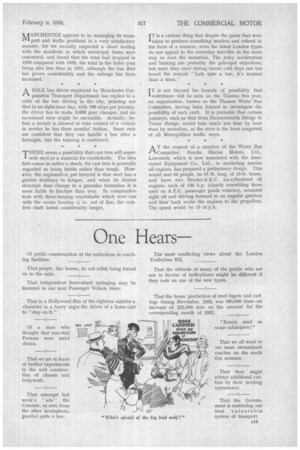Passing Comments
Page 76

Page 77

If you've noticed an error in this article please click here to report it so we can fix it.
THE railway stables still house nearly 15,000 horses, but now some 6,000 motor delivery vans are used to convey goods between works and railway goods yards. The rise in mechanization may be realized from the fact that in 1927 there were only two motor vans for every 15 horses, whilst in 1932 the proportion of vans had risen to six. The mechanical horse is also coming into its own. Eighty are to be installed at one of the important London goods depots, the total being nearly 400.
T is stated on Merseyside that new vessels are being ordered more freely, chiefly because they can be worked more cheaply than those built even a few years ago. There is more than a hint in that to commercial-vehicle operators who are inclined to cling to their obsolete machines. There is no doubt whatever that, quite apart, from the economies in taxation which the new and light type chassis effect, modern commercial motors are much more economical than those "built even a few years ago."
1VIANCEIESTER appears to be managing its trans4v1 port and traffic problems in a very satisfactory manner, for we recently inspected a chart dealing with the accidents in which municipal buses were concerned, and found that the total had dropped in 1933 compared with 1932, the total in the latter year being also less than in 1931, although the bus fleet has grown considerably and the mileage has been increased.
ASALE bus driver employed by Manchester Corporation Transport Department has replied to a critic of the bus driving in the city, pointing out that in an eight-hour day, with 100 stops per journey, the driver has to make 3,000 gear changes, and an occasional miss might be excusable. Actually, before a recruit is allowed to take control of a vehicle in service he has three months' tuition. Some men are confident that they can handle a bus after a fortnight, but -the training is continued.
THERE seems a possibility that cast iron will super1 sede steel as a material for crankshafts. The idea first comes as rather a shack, for cast iron is generally regarded as being brittle rather than tough. However, the explanation put forward is that steel has a greater tendency to fatigue, and when its fibrous structure does change to a granular formation it is more liable to fracture than iron. In comparative tests with three-bearing crankshafts which were run with the centre bearing in. out of line, the castiron shaft lasted considerably longer. IT is a curious thing that despite the pains that were taken to produce something modern and refined in the form of a tramcar, even the latest London types do not appeal to the everyday traveller in the same way as does the motorbus. The jerky acceleration and braking are probably the principal objections, but more than once during recent cold days one has heard the remark " Lets take a bus; it's warmer than a tram."
T is • not beyond the bounds of possibility that waterbuses will be seen on the Thames this year, an organization, known as the Thames Water Bus Committee, having been formed to investigate the possibility of such craft. It is probable that certain journeys, such as that from Hammersmith Bridge to Tower Bridge, would take much less time by boat than by motorbus, as the river is the least congested of all Metropolitan traffic ways.
A T the request of a member of the Water Bus A Brooke Marine Motors, Ltd., Lowestoft, which is now associated with the Associated Equipment Co., Ltd., in marketing marine oil engines, has prepared a preliminary design. This would seat 94 people, be 55 ft. long, of 13-ft. beam, and have two Brooke-A.E.C. six-cylindered oil engines, each of 130 h.p. (closely resembling those used on A.E.C. passenger goods vehicles), mounted right aft and driving forward to an angular gearbox and then back under the engines to the propellers. The speed would be 15 m.p.h.




































































































































































